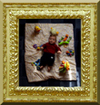DC GALLERY WITH TWO WALLS AND FLOOR: photo by Malcolm Aslett
|
Continuing my ongoing battle with the issue of photographing looking at pictures I tried this for size: showing two walls at right angles. This is an obvious way to do it, I figure, bearing in mind a preference for some kind of order in the mind of the viewer who doesn't want to be too overloaded with information. The approach then created (I didn't start off with the idea) a 'canvas' in the space inbetween (I'm talking about the floor), a kind of Barnett Newman crossed with Rothko wannabe. That works out well. Looking at the Braque and Picasso still life paintings helps in understanding that you can work things out as you go, without thinking you have to have a grand plan. I am not worrying too much on what the meaning or purpose is, rather whether it looks passable or not. The individual images in this photo were not anything special. They have a lack of sharpness too, from the low light and hand held conditions they were taken in. The top line of photos did create a nice perspective of figures in different points in space so that was okay. The second set on the right shows the usual flatness relieved by a viewer in the middle ground. Again, putting them together so that they share a corner object in different planes was not going to be a head scratcher. I positioned them in a straightforward way and fudged the spaces between so that there isn't anything too abrupt. I had originally thought I would do a forty five degree line where the walls meet but that proved unnecessary. The line of the wall transitions into the base of the right wall and that seemed good enough a link. It's a lazy photo in a lot of ways but comes out better than ones I've worked hard at because the simple design elements just happen to be strong. Squares. Rectangles. The occassional alleviation of order with a human figure. I didn't even straighten the pictures to more geometrically precise shapes even though I'm tempted to do it now. No. I'll leave it. That is the way it came out of the chute. |
|
|








